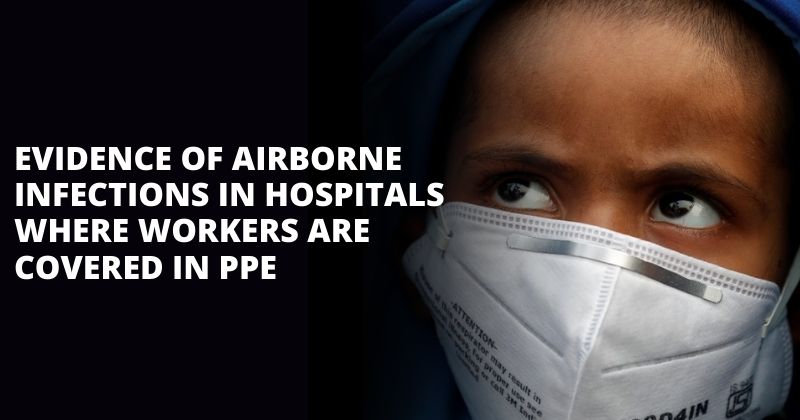A new report published in the medical journal the Lancet has found impactful evidence that the pandemic-causing SARS CoV-2 is predominantly transmitted through the air.

Getty Images
This is according to a team of six experts from the UK, the US and Canada under the leadership of Oxford’s Trish Greenhalgh who reviewed published research and identified 10 lines of evidence to support the claim that spreading of the novel coronavirus through aerosol droplets is almost non-existent and measures must be put in place to limit airborne transmission of SARS CoV-2.
Also Read: Coronavirus Spreads By Airborne Transmission, Says CDC With Updated Guideline
Jump To
![]()
Evidence of superspreader events
The first evidence that they’ve put forth is that superspreading events result in the most transmissions. Researchers have stated the example of the Skagit Choir Outbreak where 53 individuals got infected from one spreader. It states that these events didn’t have people in close contact or touching the surface.
COVID spreads more indoors
The second evidence highlighted is that the spread of the novel coronavirus is much higher indoors, compared to outdoors and indoor ventilation plays a major role here.
Most transmissions from asymptomatic, presymptomatic individuals
Third evidence states that 33 to 59 percent of all transmissions are asymptomatic or presymptomatic individuals. These aren’t coughing or sneezing, but spreading through air exhaled by those individuals, causing silent transmission.

Reuters
Evidence of long-range transmissions
In another piece of evidence, they’ve stated examples of long-range transmission of SARS CoV-2, where individuals from adjacent rooms who haven’t spoken to or come in contact with each other have taken place and have been documented in quarantine hotels.
Also Read: WHO Acknowledges Evidence Of Airborne COVID-19 Spread, Will Release Findings Soon
Transmissions despite PPE suits
Researchers have listed evidence of infections originating in hospitals even in places where healthcare workers are covered in PPE to prevent exposure from droplets.
COVID-19 has stayed infectious in the air for three hours
Researchers have also stated that SARS CoV-2 has been detected in the air in lab experiments and it has managed to stay infectious in the air for up to 3 hours. They have also rejected the argument where researchers have claimed that SARS CoV-2 wasn’t cultivated from the air, arguing that measles and TB (tuberculosis) which are airborne diseases also haven’t been cultivated from room air.
Presence of SARS CoV-2 In areas where only aerosols can reach
Researchers claim how SARS CoV-2 was found to be present in air filters and building ducts of hospitals of COVID-19 patients — areas where only aerosols can reach. In another study, they show how infected caged animals who were connected to separately caged uninfected animals via an air duct caused the transmission of SARS CoV-2 — another transmission with only aerosols as the logical explanation.

Reuters
Also Read: Sit In Open Restaurants, Avoid AC Rooms: Simulations Reveal How AC Spreads COVID-19
No conclusive evidence to refute the possibility of airborne transmission
In the ninth piece of evidence, they say how no study has as of now provided strong, consistent evidence to refute the possibility of airborne transmission of SARS CoV-2. Even though there have been instances where people have managed to avoid airborne transmission by coming in contact with an infected individual, researchers state that this could be explained through a variety of factors including variation in viral shedding as well as several environmental and ventilation conditions.
Limited evidence that SARS CoV-2 spreads via fomite
In the final evidence given by the researchers, they claim that there is limited evidence to support the spreading of SARS CoV-2 via respiratory droplets or fomite.
They explain, “Ease of infection between people in close proximity to each other has been cited as proof of respiratory droplet transmission of SARS-CoV-2. However, close-proximity transmission in most cases along with distant infection for a few when sharing air is more likely to be explained by dilution of exhaled aerosols with distance from an infected person.”

Reuters
Researchers conclude urging the public health community to seriously consider airborne transmission as a crucial way of contracting SARS CoV-2, “In conclusion, we propose that it is a scientific error to use lack of direct evidence of SARS-CoV-2 in some air samples to cast doubt on airborne transmission while overlooking the quality and strength of the overall evidence base.”
Also Read: Keep Car Windows Open To Reduce Risk Of COVID-19 Transmission, Claims Study
“There is consistent, strong evidence that SARS-CoV-2 spreads by airborne transmission. Although other routes can contribute, we believe that the airborne route is likely to be dominant. The public health community should act accordingly and without further delay.”

